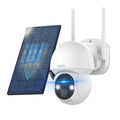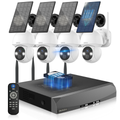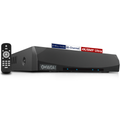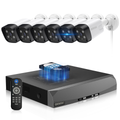Setting Up Surveillance Cameras with Routers and Handling Cross-Router Connections
Setting up surveillance cameras with routers involves configuring the network settings effectively. Additionally, handling cross-router connections, where cameras are spread across different network segments, requires careful planning to ensure seamless operation. Let's explore these scenarios and their solutions.
**Connecting Cameras to a New Router**
- **Initial Setup with New Router:**
If you've installed a new router or are using one for the first time, and you've connected it to the main network port of the DVR, you might encounter an issue where all cameras are offline. Opening the channel management interface could display errors like "network unreachable" or "username and password incorrect."
This issue typically arises from DHCP settings. When you connect a new router, the IP range changes, causing the IP of the DVR and cameras to differ. To resolve this, it's advisable to disable DHCP on the DVR. If your surveillance setup involves enterprise networks with specific IP ranges, it's best to reconfigure the cameras to match the new router's subnet. By aligning all devices within the same IP range, you not only restore video feeds but also ensure remote access via cloud services like "Yoosee Cloud." Addressing these matters can be efficiently done with remote access and minimal downtime.
It's recommended to configure camera IPs to match the router's subnet using a computer and disable the DVR's DHCP functionality for a stable setup.
**Cross-Router Connection**
- **Unified Subnet for Cross-Router Connection:**
In cases involving cross-router connections, where cameras are distributed across different segments, ensuring a unified subnet is key to establishing proper connectivity.
For instance, consider a setup where a main router has the IP 192.168.0.1, while a secondary router on the remote end uses 192.168.2.1. Meanwhile, the DVR's subnet is 192.168.0.x. To bridge these segments, reconfigure the secondary router. Disconnect its WAN (internet) port and connect it to a LAN port. Set the DHCP range of the secondary router to align with the primary router's subnet (e.g., 192.168.0.2). This setup ensures that cameras connected to the secondary router can access the DVR seamlessly.
By establishing a unified subnet across routers, you eliminate segmentation issues and enable a cohesive surveillance network.
**Incorporating Keywords:**
For individuals seeking a comprehensive security solution, options like a **security camera and recording wireless system** provide the flexibility and convenience desired. In scenarios where extensive storage is needed, an **8-camera security system** or a **wireless surveillance camera system with a hard drive** becomes indispensable. Consider the benefits of a **6-security camera system wireless** for optimal coverage, or the convenience of a **home security camera system wireless audio** to enhance monitoring capabilities.
When safeguarding a property, the choice of equipment matters. Opt for an **HD security camera system** to ensure clear and detailed footage, or explore the options provided by a **5-camera security system wireless** for versatile coverage. In terms of Italian language, the concept of **video sorveglianza casa** highlights the significance of home surveillance.
In the realm of outdoor security, the necessity of a **home security camera system outdoor wireless** becomes evident. Choosing reliable brands like OHWOAI ensures that your security needs are met with quality solutions.
**Conclusion:**
Setting up surveillance cameras with routers and managing cross-router connections requires meticulous planning and configuration. By addressing issues like DHCP settings and subnet uniformity, users can establish stable and effective surveillance networks. Moreover, choosing the right equipment, such as a **wireless CCTV camera security system**, ensures that your property remains well-protected, and remote access remains reliable. Whether it's a small-scale setup or a more extensive system, the principles of proper configuration and network alignment remain pivotal in achieving seamless surveillance functionality.
Sample Block Quote
Nam tempus turpis at metus scelerisque placerat nulla deumantos sollicitudin delos felis. Pellentesque diam dolor an elementum et lobortis at mollis ut risus. Curabitur semper sagittis mino de condimentum.










